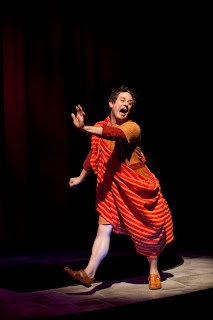
This little musical suggests there will be a Glee Club figuring in the story and providing reasons for musical numbers, but no. “Glee” in this case means gleeful, which is strange since the 13 year old boys who figure in this story set at a boarding school are anything but happy. They spend the entire 90 minutes of playing time complaining about their parents, their life at school and each other. By the end of it all they become friends––the trials and tribulations of boarding school bringing them together. The main characters each project the traits of a one line description and nothing more: The gay one likes musicals, the one that has a hard time making friends can’t make friends, the wealthy kid is stuffy and has a butler, the geek wears glasses and clings to a model boat as his only friend, the poor kid is a bit of a pudgy slob and steals things. There is nothing more. There are two older actors to play all of the adults: teachers, parents and the like. These two (Greg Horton and Erin Jerozal) draw their various characters even more broadly, picking an outrageous trait for each so that we can easily recognize the difference. This is just fine since the focus is on the boys, but there is no careful exploration of their characters. The show might be subtitled, “Episodes from the Boarding School.” We go from one incident to the next, separated by blackouts and a song to embrace each topic.
Book, music and lyrics are all by John Gregor and he has written some entertaining songs sung in good harmony by the cast (this aspect being the only link to a Glee Club idea). The most successful song of the show had nothing to do with the revelation of character, but served to cover the boy’s trip in a stolen car to Worcester with the idea of meeting some girls (“We’re Going to Worcester”). The fun and great spirit of this travel number epitomized the best of this musical and if only everything else could have hit as well, the score might have held the production together. However, as cute and as well sung as the score is, it cannot save a disjointed and inconsistent book. The opening number, “Bad Kid School,” introduces us to the characters and let’s us know they’re off to boarding school––check. That’s durable. That serves. But, that’s the end of the score providing function. “Gaul Was Divided Into Three Parts” is about Latin class (the story is contemporary and latin is not taught in American junior high boarding schools anymore). The boys don’t like Latin. “Clay’s Song” is about how Clay loves his toy boat, but we knew that from the opening number. This makes him ridiculous and no more information is given to illuminate his character. More successful is “Normal” which has the kids wishing they were something other than who they are. This is a universal feeling we can all recognize and leads to the inevitable moral that in the end they are just fine being themselves. “Home” was a lovely ballad expressing the change of heart the boys feel for their school. Their real homes are a mess, so their adopted family at school now seems more like home than the ones they left. The strange final number, “Co-ed Dorms,” has the boys dreaming about college life and the prospect of girls. It represents just another episode in the lives of middle school boys rather than an ending to a story, though the school year has come to an end. Still, on its own, the song successfully relates the feelings of adolescence.
From the beginning this musical could have gone many directions and nearly does just that without finding completion, unless the geeky kid with glasses finally parting with his beloved boat is a resolution of consequence. There is also the sentiment of the boys finally becoming a family, but this is just not enough for they never seemed like real people to begin with, so it is hard to feel very happy for them. “Boys will be boys” is about the general sum of it. There is the basis for a show here, but the author has had no interest in focussing it––he seems to have no particular statment to make about boyhood.
Igor Goldin did his best to direct this material and give it a sense of polish and made ingenious use of a small stage, but he was not influential in the formation of the material into something better than a half baked idea. This is the same half baked idea that ran in a lesser production in the 2007 New York Musical Theatre Festival. This production is enhanced by Jen Price Fick’s handsome and sturdy unit set design and a nice band headed by Music Director Daniel Feyer. THE NEW YORK TIMES critic, Neil Genzlinger, says that “real artistry is going on amid the antics.” That’s true, but no one––not director, choreographer nor author––has shown the ability to pull that artistry into a cohesive whole. If it were not for the attractive personalities of the 20-somethings playing at being 13, there wouldn’t be much of a show, so credit Zack Bandler, Christopher Davis Carlisle, Jason Edward Cook, Dan Lawler and Max Spitulnik with giving WITH GLEE the actual glee of the title.






